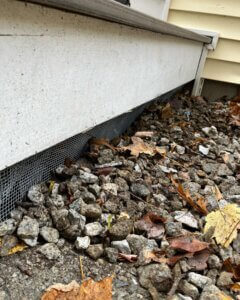Absolutely! Rodent exclusion is a highly effective method to keep unwanted rodents and wildlife out of most homes. By sealing entry points and implementing preventive measures, we create a barrier that deters rodents from invading, ensuring a pest-free environment for your family in Massachusetts.
Let’s go over what rodent exclusion is and when you might need it.
What is rodent exclusion?
Rodent exclusion is a comprehensive strategy aimed at preventing rodents from entering your home. It involves identifying and sealing potential entry points such as gaps, cracks, and openings in walls, roofs, and foundations. Skilled pest control technicians conduct a thorough inspection to pinpoint vulnerabilities and then use a combination of sealing materials, such as caulk and steel wool, to fortify these areas.
For longer-lasting solutions, contractors and specialized rodent control companies may install a permanent wildlife barrier using metal mesh and framing to block rodents from entering the foundation at the ground level and on the roof level to block birds and bats. These permanent solutions may last 20-30 years, whereas partial rodent exclusion using mesh may need to be re-addressed every few years.
Additionally, we may install barriers like door sweeps and mesh screens to further enhance protection. This proactive approach not only keeps rodents out but also safeguards your property against potential damage and health hazards associated with rodent infestations. Invest in rodent exclusion to secure your home in Massachusetts and enjoy a pest-free living space.
Why is rodent exclusion important?
Rodent exclusion is crucial for maintaining a healthy and secure home environment. While trapping mice may address immediate concerns, it doesn’t provide a long-term solution. Mice are resourceful creatures, and without proper exclusion measures, they can find new entry points and continue to cause problems. By investing in rodent exclusion, you’re not only addressing the current infestation but also preventing future ones.
This proactive approach involves identifying and sealing potential entryways, safeguarding your home against the ongoing challenges that mice can pose. It’s a comprehensive strategy that ensures peace of mind, allowing you to enjoy a pest-free home without the worry of recurrent rodent issues.
How do rodents and wildlife enter homes?
Rodents and wildlife can find ingenious ways to infiltrate homes in Massachusetts. Small openings around utility lines, gaps in siding or roofing, and even cracks in the foundation serve as convenient entry points. Mice and rats are adept climbers, utilizing overhanging branches or vines to gain access through vulnerable attic vents or openings in the roofline.
Additionally, damaged screens on windows and doors, as well as poorly sealed garage doors, can create opportunities for entry. In colder months, these pests may seek refuge in attics, basements, or crawl spaces, exploiting any weakness in the home’s structure. Regular inspections and proactive measures, such as sealing potential entry points, are essential to fortify your home against unwanted wildlife intrusion.
When does rodent exclusion NOT work?
Rodent exclusion may face challenges in situations where homeowners fail to address the root causes of the infestation. If food sources are readily available or if there are conducive environments for rodent habitation, exclusion efforts may be less effective. Additionally, poorly maintained exteriors or neglecting repairs to potential entry points can compromise the success of exclusion measures. In some cases, extreme weather conditions may create temporary vulnerabilities, requiring extra vigilance.
If neighboring properties also harbor rodent issues, a collaborative community approach may be necessary to achieve lasting results. Finally, rapid reproduction rates of rodents can pose a challenge, making it crucial for homeowners to act promptly and consistently in implementing exclusion strategies for optimal success.
So, when does rodent exclusion work?
Rodent exclusion is highly effective when implemented as part of a comprehensive pest management plan. It works best when all potential entry points, no matter how small, are identified and sealed promptly. This includes gaps in walls, roofs, and foundations, as well as openings around utility lines. Regular inspections and proactive maintenance are key to the success of rodent exclusion, ensuring that vulnerabilities are addressed promptly.
Homeowners in Massachusetts can enhance the effectiveness of exclusion by keeping the surrounding environment unattractive to rodents, such as securing food sources and maintaining a clutter-free exterior. When implemented correctly, rodent exclusion not only resolves existing infestations but also acts as a proactive barrier, preventing future rodent intrusion and safeguarding your home and family. It is a reliable and long-term solution to maintain a pest-free living space in Massachusetts.
Contact Bug Bully if you need a rodent exclusion system in Worcester or Framingham.










